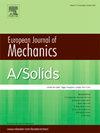Single-phase-lag thermoelastic damping in out-of-plane vibrating micro-ring resonators
IF 4.2
2区 工程技术
Q1 MECHANICS
引用次数: 0
Abstract
Thermoelastic damping (TED) has been identified as a primary energy dissipation mechanism in micro-resonators operating under vacuum conditions. The precise prediction based on the explicit TED model is crucial for optimizing micro-resonators with high quality factor. In this work, a novel two-dimensional single-phase-lag (2D-SPL) TED model is developed for the micro-ring resonator exhibiting out-of-plane vibration. The proposed model addresses the limitations of classical Fourier-based formulations, enabling more reliable TED predictions under extreme conditions. Initially, in the context of the SPL non-Fourier model, the governing equation of thermoelasticity is derived incorporating heat conduction in both transverse and circumferential directions. Subsequently, the function of fluctuation temperature is resolved using the Galerkin approach. Finally, an analytical 2D-SPL TED model is achieved through the energy-definition method. As emphases, the impacts of the equilibrium temperature, geometric dimensions, vibration frequencies, and mode orders on TED are investigated systematically. The results demonstrate that the SPL non-Fourier effect significantly affects TED at low equilibrium temperatures, high frequencies, and high-order modes. Additionally, the discrepancies among the one- and two-dimensional TED spectra become increasingly pronounced for low ratios of radius to thickness, higher frequencies, and larger mode orders.
面外振动微环谐振器的单相滞后热弹性阻尼
热弹性阻尼(TED)已被确定为真空条件下微谐振器的主要能量耗散机制。基于显式TED模型的精确预测是优化高品质因数微谐振器的关键。在这项工作中,建立了一个新的二维单相滞后(2D-SPL) TED模型,用于显示面外振动的微环谐振器。提出的模型解决了经典傅立叶公式的局限性,在极端条件下实现更可靠的TED预测。首先,在SPL非傅立叶模型的背景下,导出了包含横向和周向热传导的热弹性控制方程。随后,利用伽辽金方法求解了波动温度的函数。最后,通过能量定义方法,建立了解析2D-SPL TED模型。重点研究了平衡温度、几何尺寸、振动频率和模态阶数等因素对振动阻抗的影响。结果表明,在低平衡温度、高频率和高阶模态下,声压级非傅立叶效应显著影响TED。此外,一维和二维TED光谱之间的差异在半径与厚度的低比、更高的频率和更大的模阶下变得越来越明显。
本文章由计算机程序翻译,如有差异,请以英文原文为准。
求助全文
约1分钟内获得全文
求助全文
来源期刊
CiteScore
7.00
自引率
7.30%
发文量
275
审稿时长
48 days
期刊介绍:
The European Journal of Mechanics endash; A/Solids continues to publish articles in English in all areas of Solid Mechanics from the physical and mathematical basis to materials engineering, technological applications and methods of modern computational mechanics, both pure and applied research.

 求助内容:
求助内容: 应助结果提醒方式:
应助结果提醒方式:


